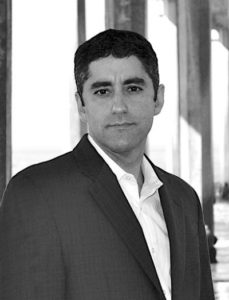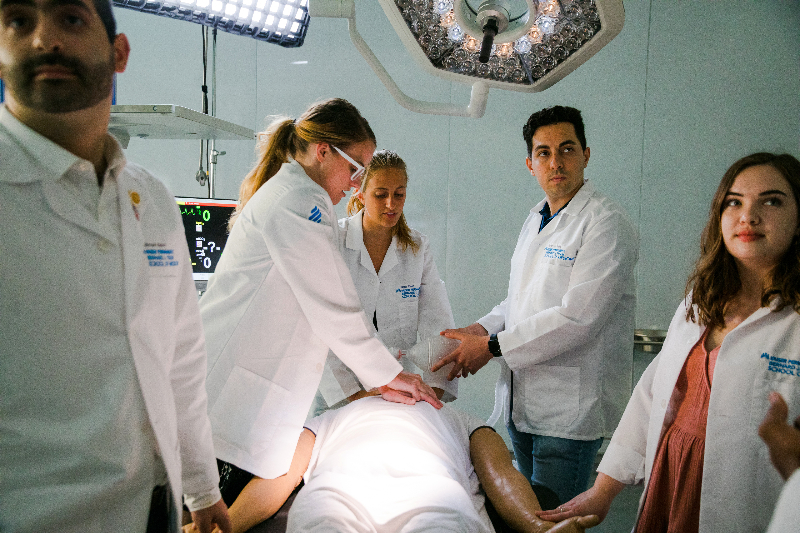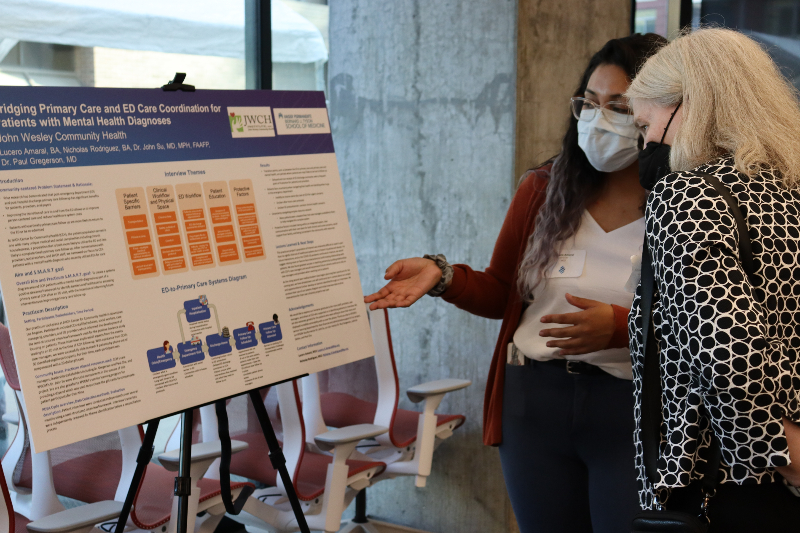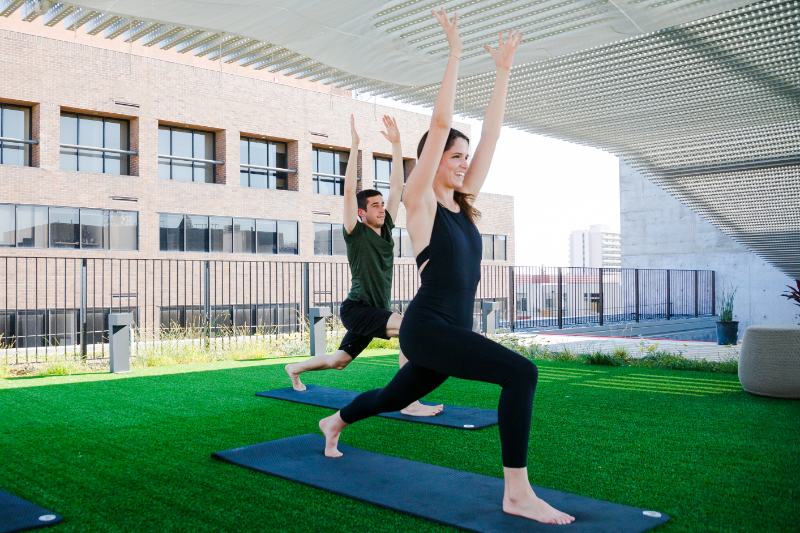Kaiser Permanente Bernard J. Tyson School of Medicine’s Simulation Center provides hands-on experience in a supportive environment.
Inside Perspective: Matthew Silver, MD, FACEP
Integrating Advanced Technologies for a Modern School of Medicine
This is a series of first-person pieces from the Permanente physicians on the ground floor of creating the new Kaiser Permanente School of Medicine.
Who am I?

I am an emergency physician with the Southern California Permanente Medical Group (SCPMG) in San Diego. I am a born, bred, and raised New Yorker, trained at Albert Einstein College of Medicine in the Bronx, N.Y., and spent the first part of my career on the faculty of Einstein’s Jacobi/Montefiore Emergency Medicine Residency Program in New York. In June 2009 I moved – kicking and screaming – to San Diego to be closer to my wife’s family. It became immediately clear that Kaiser Permanente would be an ideal setting to train emergency medicine residents.
In 2014, I along with a number of passionate educators in my department started the first of its kind Kaiser Permanente-based Emergency Medicine Residency Program in the country. As program director, I have had the great honor of seeing something that started as an idea flourish into an incredible source of pride and professional growth for our partners. With a focus on clinical medicine, evidence-based practice, and patient-centered care, our residents and the program are exceeding all expectations.
While acquiring the necessary skills and knowledge to become successful emergency physicians, our residents are gaining incredible exposure to the non-clinical facets of leadership and teamwork, wellness and resilience, quality and process improvement, and patient safety, that will allow them to be leaders in their field.
Since its inception, we have started divisions of Ultrasound and Toxicology, created an Emergency Ultrasound Fellowship, and recruited faculty with training in countless emergency medicine subspecialties. We have our sights set on further growth and development of our culture of learning and education.
We plan to open the doors of the first ever Kaiser Permanente School of Medicine. I am among several Permanente physicians across the country selected to help build the curriculum for the next generation of medical school graduates. In the coming months, we will invite more Permanente physicians to join us on this journey. In a few short years, we will have the opportunity to leverage Kaiser Permanente’s strengths to train the next generation of leaders across all medical specialties.
While certainly proud of the accomplishment of starting the residency program and being selected to participate on the School of Medicine team, I am more satisfied in thinking about the legacy these will leave on the organization and in every student and resident that we graduate who will go forth to touch and save lives.
I passionately believe that creating an environment of teaching and learning is the way to engage our partners, change our culture, and elevate our organization to new heights.
What am I doing for the School of Medicine?
In spring 2016, I joined the Kaiser Permanente School of Medicine team as part of the Curriculum Committee. I’ve always been a lover of shiny, new tech, and as part of the SCPMG Graduate Medical Education community, I started the Kaiser Permanente Technology in Education Committee (KP-TEC) to leverage technologies that could be used for the purpose of medical education.
I am now doing the same for the School of Medicine, overseeing the development, implementation, and integration of educational technologies. From electronic learning management platforms, to multimedia and interactive content, to virtual and augmented reality, we are leveraging the most advanced technologies available to enhance our students’ education.
Just envision the possibilities of learning gross anatomy by virtual reality – our students will be able to hold a beating human heart in their hands, manipulate it in 3-dimensions, zoom in on the coronary anatomy, isolate the vessels from the rest of the heart, and then in real time see what happens when there is a myocardial infarction!
Also, gone will be the days of ”see one, do one, teach one.” Our students will be able to perform procedures and work with interdisciplinary team members in fully immersive, high fidelity simulation environments, enhancing learning while preserving safety and quality.
Perhaps most exciting through enhanced analytics, we will be able to measure not only what is taught and learned but how it is applied. Traditionally, multiple choice exams have served as the cornerstone of measurement in medical schools (think shelf and United States Medical Licensing Examination or USMLE exams). Given the integrated nature of Kaiser Permanente, we have the unique ability to leverage the power of our electronic health record system, Kaiser Permanente HealthConnect®, and measure how well our students apply their knowledge in clinical practice.
How’s it going?
While we may not be working out of someone’s basement or garage, the team very much has a ”start-up” vibe. In a year’s time, the team has worked feverishly on every aspect of the Kaiser Permanente School of Medicine, from building design to curriculum and course creation. Brick by brick and byte by byte, our diverse group of Permanente physicians from Northern California, Southern California, Hawaii, and Colorado – along with our project managers and outside consultants – have begun to build an innovative, dynamic, and one-of-a-kind medical school experience. While a large part of the work so far has been at the “30,000-foot view” – readying documents that will be required for accreditation, drafting competencies, curricular maps and the “threads” that will tie everything together – we are starting to come down to ”ground level” and will soon begin work on course and content creation.
This integration of basic and clinical sciences linked together by multiple holistic threads will provide our students with a unique, comprehensive, and innovative medical education that will prepare them to practice in the 21st century and beyond.
While state-of-the-art technology will play a big role, the design of the curriculum will be completely innovative as well. Traditional medical schools divide out the basic sciences in the first two years from the clinical sciences in the third and fourth years. In this traditional approach, students learn in a vacuum and don’t apply their knowledge until they begin their clinical rotations later. The Kaiser Permanente School of Medicine will integrate the basic sciences into clinical practice from day one. This way students will be able to apply what they learn immediately.
Also novel is the integration of multiple “threads” to be woven into the basic and clinical sciences. Tied into the cases will be elements of leadership and teamwork, diversity and inclusion, lifestyle medicine, inter-professional education, health systems sciences, and discovery and inquiry. This integration of basic and clinical sciences linked together by multiple holistic threads will provide our students with a unique, comprehensive, and innovative medical education that will prepare them to practice in the 21st century and beyond.
I compare the creation of our School of Medicine very much to building a large house:
- It all starts with a vision – Why build it? Where to build it? When to build it? And of course, how are we going to get a bank loan?
- Our planning dean, Chris Cassel, MD, along with Marc Klau, MD, and Nancy Spiegel are our visionaries and two of our deans.
- Then it requires architects to draw up the blueprints for the house. Of course, we don’t want it to look like every other house on the block, so we want to make sure that it is different, but not so different that you can’t tell that it’s a house.
- This is the work that the Curriculum Committee is tasked with now – drafting the blueprints for the school.
- Along the way, you will need to submit your blueprints to the city inspectors and then undergo regular inspections to ensure your house won’t collapse, flood, or go up in flames when the homeowners move in.
- This is akin to the process of Liaison Committee on Medical Education (LCME) and Western Association of Schools and Colleges (WASC) accreditation. This will allow us to be accredited as a school of medicine and have a “.edu” as an email suffix.
- Then it takes a foreperson to oversee the coordination of the construction.
- Our stellar project managers keep our ever-growing team on task and on time.
- Once the walls are up, we will need to select paint colors, pick furniture, choose what tile we want on the backsplash, and finally have the interior decorators come in to help make the house move in ready.
- This is where we will leverage the expertise of our thousands of Permanente physicians and inter-disciplinary team members across the organization to help create the courses and support our homeowners (students) when they move in.
- Eventually the homeowners (students) move in and make the house that we have built their home.
- We’ll be announcing a move in date soon. We hope to see you at the housewarming party!


